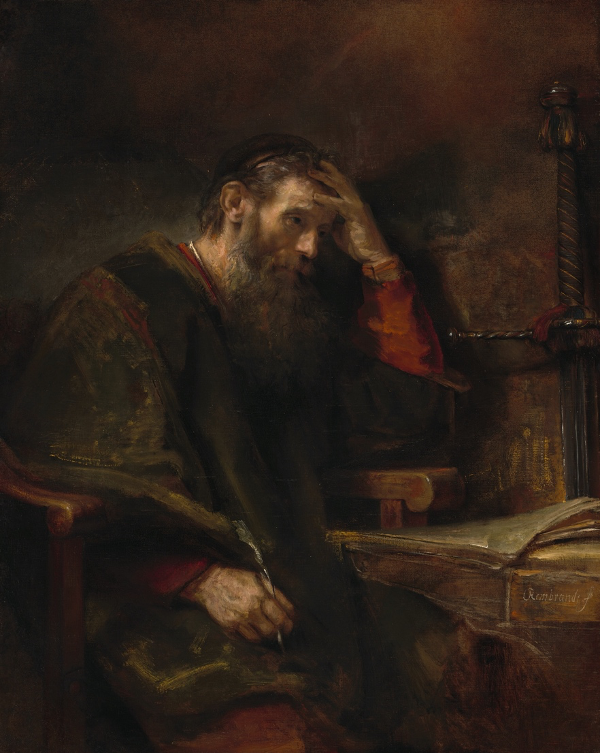St. Paul, a Citizen of No Ordinary City
Rembrandt, The Apostle Paul (oil on canvas), c. 1657
National Gallery of Art, Washington D.C.
(Listen to an audio version of the blog post above!)
I’ve written two previous blogs on St. Paul, one on speculating whether St. Paul was married and one on the logistics of St. Paul’s missionary journeys. Today, I’d like to step back and take a look at St. Paul himself, exploring the background of this remarkable Apostle.
When St. Paul is arrested in Jerusalem in A.D. 57, charged with inciting a riot and mistakenly identified as an Egyptian terrorist, he replies indignantly: “I am Jew from Tarsus in Cilicia, a citizen of no ordinary city” (Acts 21: 39). Egyptian terrorist, indeed! Later, when he is about to be flogged, St. Paul asserts his Roman citizenship in no uncertain terms, prompting an exchange with the Roman commander:
“Tell me, are you a Roman citizen?” “Yes, I am,” [Paul] answered. Then the commander said, “I had to pay a big price for my citizenship.”
“But I was born a citizen,” Paul replied.
(Acts 22: 27-28)
These two scenes speak volumes about St. Paul, and they tempt us to explore St. Paul’s background in more depth. What do we really know about St. Paul, and what informed assumptions may we make about his early, formative years?
In St. Paul’s day Tarsus was the leading city on the fertile plain of East Cilicia, located about ten miles from the mouth of the Cyndus River and about thirty miles south of the Cilician Gates. Tarsus came under Roman rule as a result of Pompey’s victories, becoming the capital of Cilicia and retaining its autonomy as a free city (67 B.C.). Cicero resided in Tarsus while serving as procounsul of Cilicia (51-50 B.C.), and Julius Caesar visited the city in 47 B.C. After Caesar’s assassination in 44 B.C., Tarsus enjoyed the favor of Antony, and it was in Tarsus in 41 B.C. that the celebrated meeting between Antony and Cleopatra took place.
Lawrence Alma-Tadema. The Meeting of Antony and Cleopatra, 41 B.C. (oil on panel), 1885.
Private collection, New York.
[Acquired from The Margaret Brown Collection, Sotheby’s auction, London, May 5, 2011.]
Shakespeare describes the meeting best, as Cleopatra’s barge glides up the Cyndus River:
The barge she sat in, like a burnish’d throne,
Burnt on the water. The poop was beaten gold,
Purple the sails, and so perfumed that
The winds were love-sick with them; the oars were silver,
Which to the tune of flutes kept stroke, and made
The water which they beat to follow faster,
As amorous of their strokes. For her own person,
It beggar’d all description: she did lie
In her pavilion—cloth of gold, of tissue—
O’er-picturing that Venus where we see
The fancy outwork nature. On each side her
Stood pretty dimpled boys, like smiling Cupids,
With divers-color’d fans, whose wind did seem to [glow] the delicate cheeks which they did cool,
And what they undid did.
(Antony and Cleopatra, II, ii, 191-204)
During the reign of Caesar Augustus (27 B.C. – A.D. 14) Tarsus enjoyed enormous privileges, including exemption from imperial taxation. An extremely prosperous city, Tarsus derived its wealth from the fertile plain on which it was located. Linen woven from flax was a major export, as was a material called cilicium, woven from goat’s hair and used as coverings to protect from the cold and wet. Strabo, the Greek historian, geographer and philosopher writes in his Geography (xiv, 5. 12ff.) that Tarsus was a leading cultural and educational center, surpassing even Athens and Alexandria. Its people, he says, were avid in their pursuit of culture, applying themselves to the study of philosophy, literature, music and the whole round of liberal arts.
When St. Paul claims to be “a citizen of no ordinary city,” he certainly has justification for doing so. And as one “born a citizen” St. Paul necessarily came from a well-to-do family. Roman citizenship was originally confined to freeborn natives of Rome, but as the Empire expanded citizenship was extended to other people in the provinces. Presumably, St. Paul’s father, grandfather or even great-grandfather had acquired Roman citizenship, either by making a significant contribution to the Roman Empire (militarily, or more likely, economically), or by purchasing Roman citizenship through political connections and cash. In addition, Dio Chrysostom, in his Oration (34, 23) tells us that enrolling as a Roman citizen in Tarsus required owning property in excess of 500 drachmae—not an easy threshold to meet. St. Paul’s family clearly had both money and status.
Although nothing suggests that St. Paul’s family were assimilated Jews (quite the contrary, Paul claims to be “a Hebrew [born] of Hebrews; in regard to the Law, a Pharisee”—Philippians 3: 5), St. Paul was deeply exposed to Greco-Roman culture and Roman education. St. Paul’s letters evidence considerable training in classical rhetoric, and when he speaks at the Areopagus in Athens he supports his argument by deftly quoting from the 6th-century B.C. Cretan poet Epimenides (Acts 17: 28), a favorite of the Stoic and Epicurean philosophers to whom he is speaking. St. Paul knew his classical literature.
At no time during Imperial Rome did the state sponsor education. Rather, children of well-to-do families were taught by private tutors or at private schools known as ludus litterarius; the teacher at such a school was called a litterator. Primary education focused on the basics of reading and writing, using Roman literary works, especially poetry, as models. Between nine and twelve years old, students from affluent families would leave their litterator and take up study with a grammaticus, who would teach his students Greek and hone their speaking and writing skills. Students would continue their study with a grammaticus until fourteen or fifteen years old, then only the most promising students would matriculate to a rhetor. Very few boys reached this level, but those who did trained with a private tutor, focusing on deliberative or judicial rhetoric. Such boys were from exclusive, wealthy families and were being groomed for the highest levels of public office and commerce. One can only speculate on what level St. Paul reached, although he is highly skilled in Greek rhetoric, easily adapting his speech and writing to his audience, suggesting he had reached a very high educational level.
At some point in St. Paul’s education his family sent him to Jerusalem for advanced religious education. Like all Jewish boys, St. Paul had been well-schooled in Scripture and Oral Law at the local synagogue, but once in Jerusalem St. Paul became a student of the greatest Rabbi of his century, Gamaliel (Acts 22: 3). The grandson of the great Hillel, Gamaliel was a leader of the Sanhedrin and possibly its President. Only the brightest and most promising students could possibly secure a position under such a man. Paul traveling from Tarsus to Jerusalem to study under Gamaliel is like Beethoven traveling from Bonn to Vienna to study under Joseph Haydn, or like a newly-minted Cal Tech Ph.D. in physics traveling from Pasadena to Cambridge for a post-doctorial fellowship under Stephen Hawking.
St. Paul had an extraordinary education, available only to the brilliant son of a wealthy and influential family. Born into privilege as a Jew and a Roman citizen, St. Paul was steeped in both secular and religious education; he was fluent in at least four languages: Hebrew, Aramaic, Greek and Latin; he was being groomed for leadership in the Sanhedrin; and he was absolutely committed to his beliefs. F.F. Bruce writes (and I paraphrase) that even if the events on the road to Damascus had never happened, history would still know of Saul of Tarsus: he was destined for greatness.
To learn more about St. Paul, watch Lesson #1 in my Romans course, a lesson titled “St. Paul the Apostle” . . . and if you become a Logos Bible Study subscriber, you can study—in-depth, verse-by-verse—all thirteen of St. Paul’s epistles and letters!


